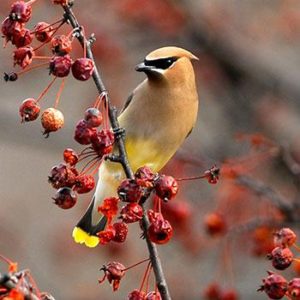Bird World Changes With the Seasons

Crabapples supply much-needed calories in winter and early spring, and cedar waxwings may stop by for a meal.
Photo credit: Jim Williams
by Val Cunningham
Contributing Writer
We can take steps to assist migrants and even the odds for backyard birds who battle the elements during our long, cold winters.
Fall is a transitional season in the bird world, most noticeably in the changeover from birds that migrate to resident species. One day may be filled with the calls of warblers, sapsuckers and sparrows, and the next almost silent as these birds continue to move southward.
I always listen for a high-pitched “squeet” calls, announcing my favorite autumn visitors, the white-throated sparrows that drop in to scrabble on the ground for a few days or a week. (Find out more here).
By the middle of October, the backyard again belongs to our year-round birds, the woodpeckers, chickadees, cardinals and blue jays. But never fear, bird watching in late fall and winter can be very rewarding, especially if you provide an inviting habitat to encourage them.
Berry fat
If you’ve grown weary of hearing that it’s always best to plant native species, consider this fact: In fall and winter, birds are hungry for the fat and energy that berries provide, and native berries hold much more nutrition than aliens do. New York researchers found the fat content of native berries to be around 32 to 50 percent, while nonnative berries averaged less than 1 percent. So non-native berries are of little value.
Migrating birds need a lot of fat to fuel their rapid metabolisms, and birds that spend the winter here need it even more. So if you plant dogwood shrubs and high bush cranberry for fall berry consumption, and winterberry or sumac for winter fruit, you’ll be providing critical calories for backyard birds. Birds seem to know there’s a difference, since they almost always strip berries from native plants first.
Give ‘em shelter
Places where birds can escape from the wind, snow and cold is an important element of their survival. It’s simply not the case that year round birds easily withstand our long winters (even if winter nights are now warmer than they used to be). Birds need to be healthy and in top form to make it through day after day of adverse conditions. Anything we can do to provide shelter from the elements gives them an edge. One reader wrote to suggest planting raspberries, since the bent canes hold snow, creating snow caves for birds and other wildlife.
Planting evergreen trees and shrubs is one of the best things you can do, both to liven up the backyard and provide places for birds to huddle. I’ve noticed how popular the two threadleaf false cypress evergreens are in my backyard: Birds come and go all day long, after warming up within their dense branches. The same goes for some dwarf mugo pines and several low arborvitae shrubs—birds make constant use of their sheltering limbs.
You’ll notice that these evergreens aren’t natives, and this is because there aren’t many native evergreens that fit into a small backyard. But I planted two young Black Hills spruce trees about five years ago and once they gain a bit more altitude birds will find safe haven within their branches.
How about building up a brush pile in a spot that’s out of the wind? This needn’t be an elaborate structure, just a pile of limbs you’ve pruned from trees, or those that fall naturally. Here is a site to get you started. Toss some millet seed nearby each day and birds will show up in droves.
Food and ‘lumber’
Don’t be a neat freak around your landscapes. Birds will really appreciate it if you leave those plant stalks standing over the winter, since flowering plants go to seed, and most winter birds, especially the finches, relish the seeds. Then, in the spring, birds will make use of the withering stalks as nest-building material. Baltimore orioles and others are on the lookout for plant vegetation to weave into nests, and will strip plants like old milkweed stalks for their strong fibers.
Providing food in feeders is a great way to attract birds, and you can easily enhance your backyard’s “bird magnetism” by adding natural foods and shelter.
St. Paul, Minn., resident Val Cunningham, who leads bird hikes for the St. Paul Audubon Society and writes about nature for local, regional and national newspapers and magazines.



